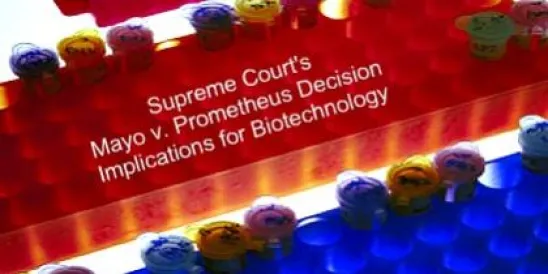On March 20, 2012, the United States Supreme Court issued a unanimous decision in Mayo Collaborative Services v. Prometheus Labs., Inc., finding invalid Prometheus's patent claims relating to methods of optimizing the dosage of a drug because those claims sought to cover a law of nature. Supreme Court precedent has consistently placed laws of nature outside the scope of patentable subject matter. The Mayo decision further defined the scope of patentable subject matter in a manner that will have significant implications for the diagnostic, pharmaceutical, biotechnology industries.
Background
The patents at issue in Mayo relate to methods of optimizing the dosage of a particular drug to treat autoimmune conditions such as inflammatory bowel disease. The claimed treatment regimen takes into account the toxicity of the drug and responsiveness of the patient in some cases. To optimize this treatment, the Prometheus patents disclose a method of adjusting a drug dosage based on the level of a metabolite in patients treated with the drug. Prometheus brought an action for patent infringement against Mayo, which had developed its own diagnostic test for a patient's metabolism of the drug.
This is the second time the Supreme Court granted review of the Prometheus case. In 2009, the Court of Appeals for the Federal Circuit found the very same claims patentable applying the "machine-or-transformation" test employed by the Federal Circuit at that time to evaluate whether claimed subject matter was eligible for a patent.2 In Bilski v. Kappos, decided after the first Prometheus decision, the Supreme Court rejected the "machine-or-transformation" test as the sole, definitive test for patentable subject matter.3 Instead, the Supreme Court focused on the language of Section 101 of the patent statute (35 U.S.C. ý 1 et seq.) and held, based on its earlier precedents, laws of nature, physical phenomena, and abstract ideas are not patentable.4 The Supreme Court then vacated and remanded the Federal Circuit's 2009 Prometheus decision for reconsideration in light of the Supreme Court's opinion in Bilski. On remand, the Federal Circuit held that while the machine-or-transformation test may not be the exclusive test for determining patentable subject matter, the fact that the methods claimed by Prometheus led to a transformation in a treated patient was sufficient to find Prometheus' claims patentable.5 The Supreme Court then granted review of the second Federal Circuit opinion in 2011.
The Supreme Court Decision
In its most recent review of the case, the Supreme Court found that Prometheus' claims set forth a law of nature — the relationship between a patient's metabolizing of a particular drug and the resulting determination and administration of an effective dose of that drug. The Court then analyzed whether the claims applied a law of nature, as would a linear accelerator, for example, apply Einstein's law of special relativity, or whether the claims simply stated a law of nature and instructed the public to apply that law. After reviewing the steps of the claimed method, the Supreme Court found that the steps to determine the metabolite concentration and administer the drug according to the metabolite concentration were conventional activities used previously by those of skill in the art. In other words, the conventional steps of determining and administering did not present a patentable application of the law of nature.
In reaching this conclusion, the Supreme Court raised the concern that claims covering natural laws would inhibit, rather than promote, innovation. This concern is particularly acute when the claim simply instructs the public to apply a law of nature. Although the law of nature at issue in Mayo is admittedly narrow, the Supreme Court stated that Prometheus's claims could block others from more refined dosage recommendations, such as Mayo's.
The Mayo decision then addressed several arguments brought by various amici in support of Prometheus. For example, the United States Government argued that the patent eligibility requirement set forth in Section 101 of the Patent Act was not intended to be a stringent bar for patentability, like the requirements of novelty (Section 102), nonobviousness (Section 103), and an adequate written description (Section 112). The Supreme Court rejected the Government's attempt to divide the inquiries because it would effectively render the patentable subject matter requirement meaningless.
The Supreme Court also addressed the concern of several amici that a decision against Prometheus would reduce the ability of biomedical researchers to protect discoveries in medical diagnostics. Those amici argued that this is an especially important concern for scientists working in the growing field of personalized medicine, "a form of medicine that uses information about a person's genes, proteins, and environment to prevent, diagnose, and treat disease."6 However, many medical organizations, such as the American Medical Association, opposed Prometheus's patents as potentially blocking doctors from providing the best care to patients. Ultimately, the Court found that these competing interests of researchers and practitioners indicated that there is no strong policy reason to depart from well-established rules defining the scope of patent-eligible subject matter.
Conclusion
The Mayo decision serves as a strong reminder that laws of nature are excluded from patent-eligible subject matter. The decision leaves open to patent eligibility claims that represent a particular, useful application of a law of nature. The Mayo decision may well have important consequences for diagnostic, pharmaceutical and biotechnology companies, and could potentially limit the scope of patents available to innovators in those industries.
Moreover, the Mayo decision casts some doubt on the vitality of the Federal Circuit's holding in Association for Molecular Pathology v. United States Patent and Trademark Office (commonly referred to as the "Myriad" case).7 In Myriad, the Federal Circuit held that claims relating to isolated DNA sequences from human genes, related to susceptibility for breast cancer, constituted patentable subject matter. The Supreme Court is now considering whether to review the Federal Circuit's Myriad decision. The Supreme Court now may remand Myriad back to the Federal Circuit to reconsider whether isolated human DNA sequences are patent eligible subject matter in light of the Mayo decision.
1 This client alert has been prepared by members of Schiff Hardin's Intellectual Property Practice, who concentrate their practices in biologics and pharmaceutical products, including D. Christopher Ohly (Washington, D.C.), Sailesh K. Patel (Chicago), George Yu (San Francisco) and Stephen Hankins. For further information about the contents and specific subject matter of this client alert, please contact George Yu, in our San Francisco office.
2Prometheus Labs., Inc. v. Mayo Collaborative Services, 581 F.3d 1336, 1345-49 ((Fed. Cir. 2009) ("Prometheus I").
3Bilski v. Kappos, 130 S.Ct. 3218, 3226-27 (2010).
4Id.
5Prometheus Labs., Inc. v. Mayo Collaborative Services, 628 F.3d 1347, 1355 (Fed. Cir. 2010).
6http://www.cancer.gov/dictionary/?CdrID=561717.
7 653 F.3d 1329 (Fed. Cir. 2011).



 />i
/>i

